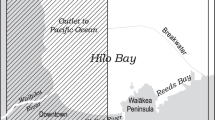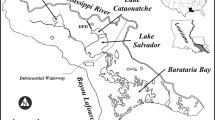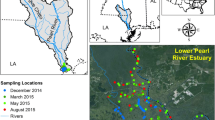Abstract
Environmental factors that influenced the rates of water exchange in a series of tidal, dead-end canals in Crystal River, Florida, were investigated by measuring the rates of dilution of the fluorescent dye Rhodamine WT. Water temperature regime was the most influential of these factors, with type of tidal cycle (spring or neap) and density of submersed vegetation (dominated byHydrilla verticillata) only affecting dye dilution rates in winter treatments. Dye half-lives were shortest in the summer (12–24 h), longest in the fall and spring (60–120 h), and most sensitive to water temperature patterns in the winter (26–60 h). These data provide useful information relating to the timing of hydrilla management using aquatic herbicides in spring-fed tidal systems. A mechanism is proposed that relates the canal water temperatures to tidal water movement and outputs from the adjacent Three Sisters Springs.
Similar content being viewed by others
Literature Cited
Bowmer, K. H. 1982. Residues of glyphosate in irrigation water.Pesticide Science 13:623–638.
Demint, R. J. 1970. Use of dye as a model of herbicide dissipation in irrigation water.Proceedings of the Western Weed Science Society 23:45–51.
Feuerstein, D. L. andR. E. Selleck. 1963. Fluorescent tracters for dispersion measurements.Journal of the Sanitary Engineers Division A.S.C.E. 89:1–21.
Fox, A. M. and W. T. Haller. 1990. Use of Rhodamine WT dye to predict herbicide dissipation in moving water, p. 105–110.In P. R. F. Barrett, M. P. Greaves, K. J. Murphy, A. H. Pieterse, M. P. Wade, and M. Wallsten (eds.),Proceedings of the European Weed Research Society/AAB 8th Symposium on Aquatic Weeds, 1990, Wageningen, The Netherlands.
Fox, A. M., W. T. Haller, andK. D. Getsinger. 1988. Preliminary study of the dilution of dyes in tidal canals of the Crystal River, Florida, p. 195–201.In Proceedings, 22nd Annual Meeting, Aquatic Plant Control Research Program. Miscellaneous Paper A-88-5, US Army Engineer Waterways Experiment Station. Vicksburg, Mississppi.
Fox, A. M., W. T. Haller, andK. D. Getsinger. 1989. Factors affecting the dispersion of dyes in tidal canals in the Crystal River, Florida, p. 103–105.In Proceedings, 23nd Annual Meeting, Aquatic Plant Control Research Program. Miscellaneous Paper A-89-1. US Army Engineer Waterways Experiment Station, Vicksburg, Mississippi.
Fox, A. M., W. T. Haller, andD. G. Shilling. 1991. Correlation of fluridone and dye concentrations in water following concurrent application.Pesticide Science 31:25–36.
Getsinger, K. D. 1988. Development of herbicide application techniques for flowing water, p. 189–194.In Proceedings, 22nd Annual Meeting, Aquatic Plant Control Research Program. Miscellaneous Paper A-88-5, US Army Engineer Waterways Experiment Station, Vicksburg, Mississippi.
Golterman, H. L. 1975. Developments in Water Science. 2. Physiological Limnology. Elsevier Scientific Publishing Company. Amsterdam, The Netherlands. 489 p.
Johnson, M. C. 1984. Fluorometric techniques for tracing reservoir inflows. Instruction Report E-84-1, US Army Engineer Waterways Experiment Station, Vicksburg, Mississippi. 46 p.
Langeland, K. A. and D. J. DeMont. 1986. Considerations for using herbicides for aquatic weed control in domestic water supplies of North Carolina. Report of the Water Resources Research Institute, University of North Carolina, Raleigh, North Carolina. 116 p.
Maceina, M. J. andJ. V. Shireman. 1980. The use of a recording fathometer for determination of distribution and biomass ofHydrilla.Journal of Aquatic Plant Management 18:34–39.
Paul, D. R. 1978. A mathematical model for evaluating the flushing characteristics of small tidal bays. M.Sc. Thesis, University of Florida, Cainesville, Florida. 96 p.
SAS Institute, Inc 1985. SAS User’s Guide: Statistics, Version 5 Edition, Cary, North Carolina. 956 p.
Marst, P. L. andI. M. S. Laidlaw. 1977. An evaluation of some fluorescent dyes for water tracings.Water Resources Research 13:15–33.
Wilson, J. F., E. D. Cobb, andA. Kilpatrick. 1986. Fluorometric procedures for dye tracing. Chapter A12. Book 3, Applications of Hydraulics—Techniques of Water-Resources Investigations of the United States. Geological Survey. US Government Printing Office, Washington, D.C. 34 p.
Author information
Authors and Affiliations
Rights and permissions
About this article
Cite this article
Fox, A.M., Haller, W.T. & Getsinger, K.D. Factors that influence water exchange in spring-fed tidal canals. Estuaries 14, 404–413 (1991). https://doi.org/10.2307/1352265
Issue Date:
DOI: https://doi.org/10.2307/1352265




